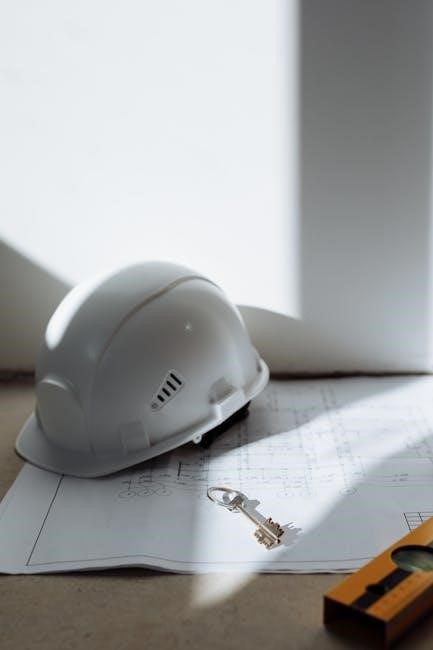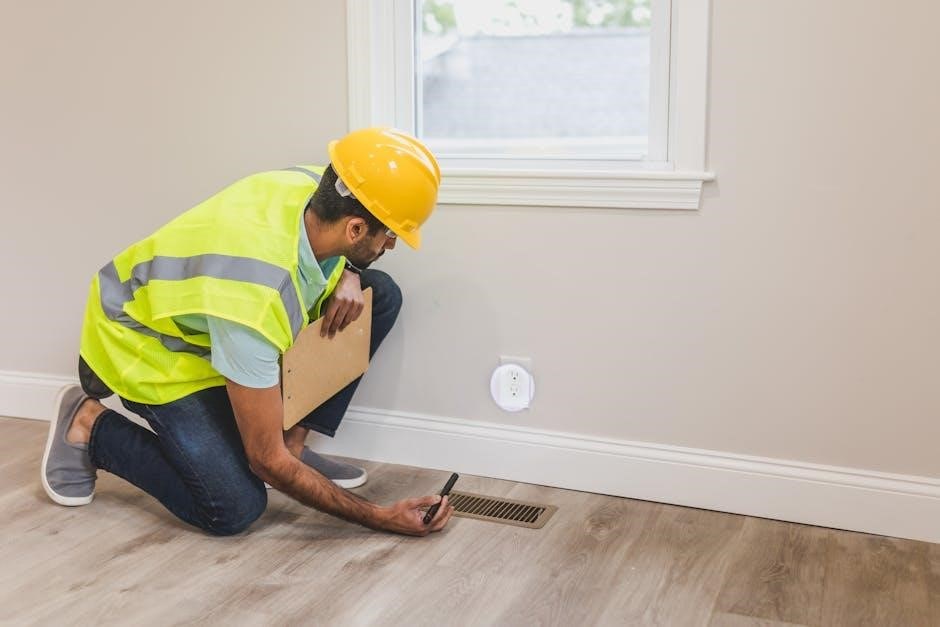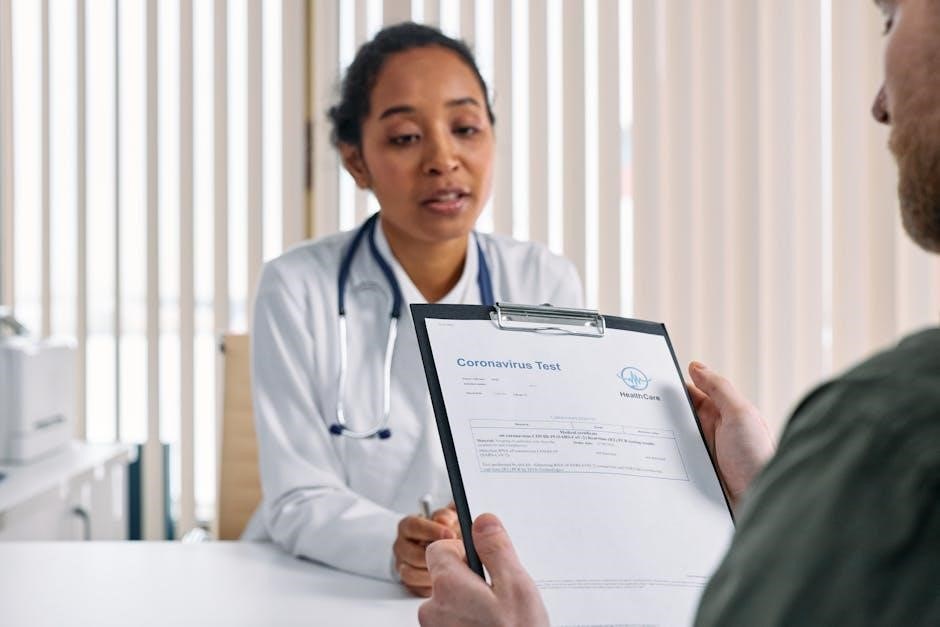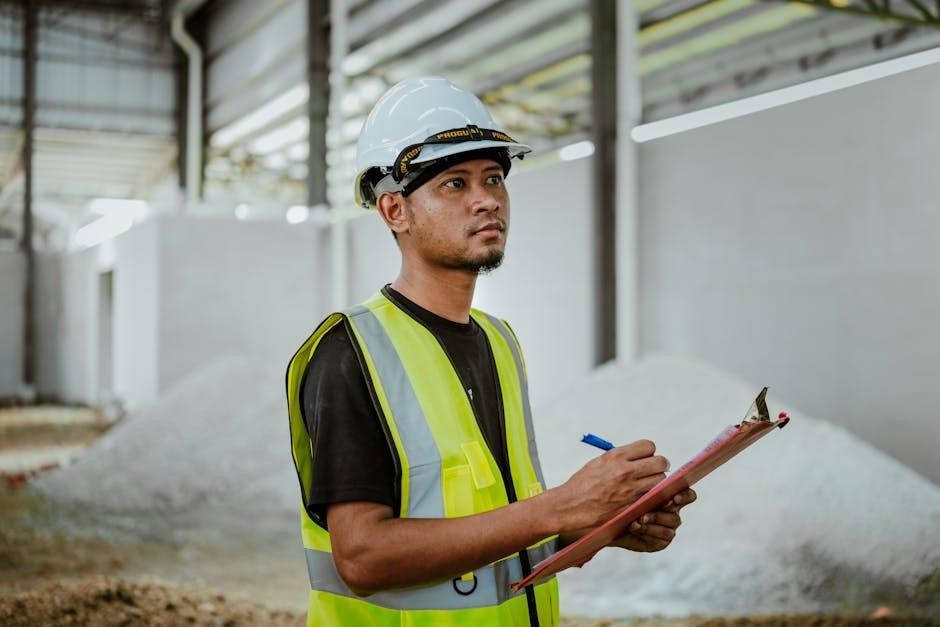The Kinder Morgan Contractor Safety Program ensures a safe working environment, protecting personnel and the environment. It emphasizes compliance with regulations and continuous improvement in safety practices.
Overview of the Safety Program

The Kinder Morgan Contractor Safety Program is designed to ensure a safe and healthy work environment for all contractors and employees. It outlines clear guidelines and expectations to prevent incidents and protect the environment. The program emphasizes compliance with industry standards, regulatory requirements, and company policies. Key components include training, hazard identification, and emergency preparedness. Contractors are required to adhere to specific safety protocols, such as wearing personal protective equipment (PPE) and following lockout/tagout procedures. The program also promotes a culture of safety, encouraging continuous improvement and accountability. By fostering collaboration and awareness, Kinder Morgan aims to minimize risks and ensure a secure workplace for everyone involved.
Importance of Safety Training for Contractors

Safety training is crucial for contractors working with Kinder Morgan, as it ensures compliance with industry standards and company policies. Proper training fosters a culture of safety, reducing workplace incidents and environmental risks. Contractors gain knowledge on hazard identification, emergency response, and the use of personal protective equipment (PPE). This training also emphasizes accountability, ensuring that all personnel understand their roles in maintaining a safe environment. By prioritizing safety education, Kinder Morgan promotes a proactive approach to risk management, protecting both workers and the environment. Regular training updates ensure that contractors stay informed about the latest safety protocols and regulatory requirements, further enhancing workplace safety.

Key Components of the Kinder Morgan Safety Test
The Kinder Morgan Safety Test covers compliance with safety standards, hazard identification, emergency response, PPE requirements, and safe work practices to ensure a safe working environment and environmental protection.
Personal Protective Equipment (PPE) Requirements
Personal Protective Equipment (PPE) is a critical component of the Kinder Morgan Contractor Safety Program. Contractors must wear hard hats, safety glasses, and steel-toed shoes in maintenance or production areas, even when not actively working. High-visibility clothing is required in areas with vehicular traffic or heavy machinery. Respirators and gloves must be used when handling hazardous materials or performing tasks that involve chemical exposure. PPE requirements are non-negotiable and ensure compliance with industry standards to protect workers from potential hazards. Failure to adhere to these guidelines may result in disciplinary action. Proper PPE ensures a safe working environment and aligns with Kinder Morgan’s commitment to workplace safety and environmental protection.

Emergency Procedures and Response Plans
Kinder Morgan’s Contractor Safety Program includes comprehensive emergency procedures and response plans to ensure prompt and effective action during incidents. Contractors must familiarize themselves with evacuation routes, emergency contact protocols, and spill response measures. Regular drills and training sessions are conducted to prepare personnel for potential hazards. In case of emergencies, contractors are required to follow established protocols, including alerting supervisors and securing the area. Fire extinguisher locations and proper usage are also emphasized. These plans are regularly updated to align with industry standards and regulatory requirements, ensuring a swift and coordinated response to minimize risks and protect people and the environment.
Hazard Identification and Risk Assessment

Hazard identification and risk assessment are critical components of Kinder Morgan’s Contractor Safety Program. Contractors are required to identify potential hazards in their work areas, such as chemical exposures, equipment malfunctions, or environmental risks. A thorough risk assessment is conducted to evaluate the likelihood and severity of these hazards. This process involves inspections, hazard checklists, and consultations with safety experts. Contractors must implement controls, such as engineering solutions or PPE, to mitigate risks. Regular reviews and updates ensure that hazard assessments remain effective. This proactive approach protects personnel, assets, and the environment, aligning with Kinder Morgan’s commitment to operational excellence and safety. Proper hazard management is essential for maintaining a safe work environment.
Regulatory Compliance and Standards

Kinder Morgan ensures contractors comply with pipeline safety and environmental regulations, adhering to strict standards for operational excellence and environmental protection, ensuring a safe workplace.
Pipeline Safety Regulations and Requirements
Kinder Morgan adheres to strict pipeline safety regulations, ensuring compliance with federal and industry standards. Contractors must follow specific guidelines for NDT testing, exceeding requirements to guarantee operational integrity. Safety protocols include regular inspections and audits to maintain compliance. Contractors are expected to understand and implement these regulations, ensuring safe practices during all operations. The program emphasizes adherence to environmental and safety standards, protecting both personnel and the environment. By aligning with these regulations, Kinder Morgan promotes a culture of safety and accountability, ensuring all pipeline activities meet or exceed industry benchmarks for reliability and sustainability.
Environmental Safety Standards
Kinder Morgan prioritizes environmental safety, ensuring all operations comply with stringent standards to protect ecosystems. Contractors must adhere to specific protocols for spill prevention, waste management, and emissions control. Environmental safety training is mandatory, emphasizing the importance of sustainable practices. The program requires contractors to follow detailed guidelines to minimize ecological impact, ensuring compliance with federal and state regulations. Regular audits and inspections are conducted to verify adherence to these standards. By integrating environmental safety into daily operations, Kinder Morgan promotes a culture of responsibility and sustainability, safeguarding the environment for future generations while maintaining operational excellence.

Safe Work Practices
Kinder Morgan’s Safe Work Practices ensure tasks are performed safely, adhering to regulations, minimizing risks, and promoting continuous improvement in workplace safety and environmental protection.
Lockout/Tagout Procedures
Lockout/Tagout (LOTO) procedures are critical for ensuring equipment safety during maintenance. Contractors must identify energy sources, disconnect, and apply locks/tags to prevent accidental start-up. All affected employees must be notified, and locks must be removed only by authorized personnel. Proper verification of energy isolation is essential before starting work. Non-compliance with LOTO procedures can lead to severe injuries or fatalities. Kinder Morgan enforces strict adherence to these protocols to safeguard workers and maintain operational integrity. Regular training and audits ensure contractors understand and follow LOTO requirements effectively, aligning with industry standards and regulatory expectations for workplace safety.
Hot Work Permits and Safety Measures
Hot work activities, such as welding or cutting, require strict safety protocols. Contractors must obtain a hot work permit before starting, ensuring the area is safe and free from hazards. Fire extinguishers and trained personnel must be present, and the work area should be well-ventilated to prevent gas accumulation. Sparks and slag must be controlled to avoid igniting flammable materials. Kinder Morgan mandates pre-job safety checks and continuous monitoring during hot work operations. Non-compliance can result in permit revocation or work stoppage. Proper training and adherence to these measures are essential to prevent fires and ensure a safe working environment, aligning with industry and regulatory standards.

Incident Reporting and Investigation
Incident reporting is crucial for maintaining safety. Contractors must report incidents promptly, and investigations are conducted to identify root causes and implement corrective actions.
Procedures for Reporting Incidents
Contractors must immediately notify supervisors of any incidents, including near misses or injuries. A detailed incident report must be submitted within 24 hours, outlining what happened, who was involved, and any witness statements. The report should include root cause analysis to identify contributing factors. All incidents are reviewed to implement corrective actions and prevent future occurrences. Contractors are required to cooperate fully during investigations. Timely and accurate reporting ensures accountability and continuous improvement in safety practices. This process is critical for maintaining a safe work environment and protecting all personnel and assets. Proper documentation and communication are essential for effective incident management.
Root Cause Analysis and Corrective Actions
Root cause analysis (RCA) is a critical step in addressing incidents, identifying underlying causes, and preventing recurrence. Contractors must participate in RCA processes, such as the 5 Whys or fishbone diagrams, to determine the origin of incidents. Corrective actions are developed based on RCA findings, focusing on systemic improvements rather than blame. These actions may include updated procedures, additional training, or equipment modifications. Implementation is tracked to ensure effectiveness. The goal is to create sustainable solutions that enhance safety and reduce risks. Continuous monitoring and feedback loops are essential to verify the success of corrective measures and foster a proactive safety culture.

Training and Orientation
The Kinder Morgan Contractor Safety Program provides comprehensive training and orientation to ensure contractors meet safety standards, comply with regulations, and protect the environment effectively.
Contractor Orientation Process
The Contractor Orientation Process ensures all contractors understand Kinder Morgan’s safety culture, policies, and expectations. It covers PPE requirements, emergency procedures, and hazard identification. Contractors review safety manuals and environmental standards, ensuring compliance with regulations. The process emphasizes continuous improvement and accountability, fostering a safe workplace. Orientation is mandatory before site access, ensuring everyone is aligned with Kinder Morgan’s commitment to safety and environmental protection.
Refresher Training Requirements
Refresher training is essential for contractors to stay updated on Kinder Morgan’s safety standards and regulatory changes. These sessions are typically required annually or when specific safety protocols are updated. They cover critical topics such as emergency procedures, PPE use, and hazard identification. Contractors must complete refresher training to maintain compliance and ensure a safe working environment. Failure to comply may result in restricted site access. Refresher training reinforces Kinder Morgan’s commitment to continuous improvement in safety practices and environmental protection, ensuring all contractors are aligned with the latest industry standards and company policies.
Additional Safety Resources
Kinder Morgan offers contractors access to safety manuals, guidelines, and toolbox talks. Regular safety meetings ensure updated knowledge and adherence to safety protocols.
Toolbox Talks and Safety Meetings
Toolbox talks and safety meetings are essential components of Kinder Morgan’s safety program. These regular sessions ensure contractors stay updated on safety protocols, industry standards, and best practices. They provide a platform for discussing job-specific hazards, emergency procedures, and PPE requirements. Contractors are encouraged to actively participate, sharing experiences and insights to foster a culture of safety. These meetings also serve as a reminder of Kinder Morgan’s commitment to continuous improvement in workplace safety. Attendance is mandatory for all contractors and supervisors to ensure alignment with the company’s safety standards and regulatory compliance. Regular engagement in these discussions helps maintain a safe and healthy work environment.
Access to Safety Manuals and Guidelines
Kinder Morgan provides contractors with comprehensive safety manuals and guidelines to ensure compliance with industry standards and company policies. These documents outline specific requirements for pipeline safety, environmental protection, and personal protective equipment (PPE). Contractors are expected to review and adhere to these guidelines, which are regularly updated to reflect current regulations and best practices. Access to these materials is typically provided during orientation or through the company’s intranet. The guidelines also cover emergency response plans, hazard identification, and safe work practices. By ensuring all contractors have access to these resources, Kinder Morgan promotes a culture of safety and accountability, reducing risks and ensuring a safe working environment.
Conclusion
The Kinder Morgan Contractor Safety Program commits to ensuring a safe and healthy work environment, protecting the environment, and fostering a culture of accountability and continuous improvement.
Final Thoughts on Contractor Safety
The Kinder Morgan Contractor Safety Program underscores the importance of a strong safety culture, emphasizing accountability and continuous improvement. Contractors play a vital role in maintaining safe practices, adhering to regulations, and protecting the environment. Regular training and adherence to safety protocols are essential for minimizing risks and ensuring compliance. By fostering a culture of safety, Kinder Morgan promotes a workplace where everyone returns home safely. Contractors must remain vigilant, report incidents, and participate in ongoing training to uphold these standards. Safety is a shared responsibility, and collective efforts ensure the well-being of all personnel and the environment.
Continuous Improvement in Safety Practices
Kinder Morgan prioritizes continuous improvement in safety practices to ensure a safe and healthy work environment. Regular assessments and updates to safety protocols are conducted to align with industry standards and regulatory requirements. Contractors are encouraged to provide feedback and participate in safety meetings to identify areas for enhancement. Toolbox talks and training sessions are integral to fostering a culture of ongoing learning and adaptation. By staying updated on best practices and incorporating lessons learned from incidents, Kinder Morgan strives to minimize risks and enhance overall safety performance. This commitment ensures that safety remains a core value, driving operational excellence and environmental stewardship.
